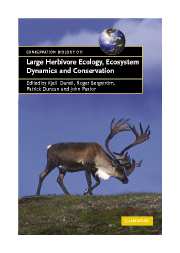Book contents
- Frontmatter
- Contents
- List of contributors
- Preface
- Introduction
- 1 Large herbivores across biomes
- 2 Living in a seasonal environment
- 3 Linking functional responses and foraging behaviour to population dynamics
- 4 Impacts of large herbivores on plant community structure and dynamics
- 5 Long‐term effects of herbivory on plant diversity and functional types in arid ecosystems
- 6 The influence of large herbivores on tree recruitment and forest dynamics
- 7 Large herbivores: missing partners of western European light‐demanding tree and shrub species?
- 8 Frugivory in large mammalian herbivores
- 9 Large herbivores as sources of disturbance in ecosystems
- 10 The roles of large herbivores in ecosystem nutrient cycles
- 11 Large herbivores in heterogeneous grassland ecosystems
- 12 Modelling of large herbivore–vegetation interactions in a landscape context
- 13 Effects of large herbivores on other fauna
- 14 The future role of large carnivores in terrestrial trophic interactions: the northern temperate view
- 15 Restoring the functions of grazed ecosystems
- 16 Themes and future directions in herbivore‐ecosystem interactions and conservation
- Index
- References
10 - The roles of large herbivores in ecosystem nutrient cycles
Published online by Cambridge University Press: 16 November 2009
- Frontmatter
- Contents
- List of contributors
- Preface
- Introduction
- 1 Large herbivores across biomes
- 2 Living in a seasonal environment
- 3 Linking functional responses and foraging behaviour to population dynamics
- 4 Impacts of large herbivores on plant community structure and dynamics
- 5 Long‐term effects of herbivory on plant diversity and functional types in arid ecosystems
- 6 The influence of large herbivores on tree recruitment and forest dynamics
- 7 Large herbivores: missing partners of western European light‐demanding tree and shrub species?
- 8 Frugivory in large mammalian herbivores
- 9 Large herbivores as sources of disturbance in ecosystems
- 10 The roles of large herbivores in ecosystem nutrient cycles
- 11 Large herbivores in heterogeneous grassland ecosystems
- 12 Modelling of large herbivore–vegetation interactions in a landscape context
- 13 Effects of large herbivores on other fauna
- 14 The future role of large carnivores in terrestrial trophic interactions: the northern temperate view
- 15 Restoring the functions of grazed ecosystems
- 16 Themes and future directions in herbivore‐ecosystem interactions and conservation
- Index
- References
Summary
INTRODUCTION
The question of how herbivores control various ecosystem processes has had a long history in modern ecology. In a now much‐cited paper, Hairston et al. (1960) proposed that in the absence of predators, herbivore populations increase to the limit set by their food supply and thus control net or actual productivity and energy flow. With the addition of predators, herbivore populations become controlled from above; plant productivity is then released from direct control by herbivores and instead is limited by abiotic processes such as climate. These ideas have been developed further by Oksanen and colleagues (Oksanen et al. 1981, Oksanen 1983, 1988). In order to simplify the concepts and models, these studies have ignored the way that the cycling of nutrients between decomposers and higher trophic levels limits net primary productivity in most ecosystems, and the many mechanisms by which herbivores alter nutrient flows through decomposers and soils.
Early recognition of the roles of herbivores in regulating nutrient cycles focused on phytophagous insects (Mattson & Addy 1975) or phytoplanktivorous zooplankton (Kitchell et al. 1979). Perhaps this was because of their ubiquity, rapid population growth rates, high turnover rates and because (at least in the case of zooplankton) they consume most of the primary production (Macfadyen 1964). With the exception of large herds in grasslands (Sinclair & Norton‐Griffiths 1979) and microtine populations in tundra (Schultz 1964), the possibility that mammals could also regulate nutrient cycles was generally ignored for quite some time.
- Type
- Chapter
- Information
- Large Herbivore Ecology, Ecosystem Dynamics and Conservation , pp. 289 - 325Publisher: Cambridge University PressPrint publication year: 2006
References
- 68
- Cited by

